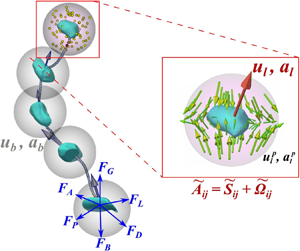Article contents
Experimental investigation of the acceleration statistics and added-mass force of deformable bubbles in intense turbulence
Published online by Cambridge University Press: 18 February 2021
Abstract

We present an experimental investigation of the acceleration statistics and the added mass tensor of deformable gas bubbles in turbulence. By simultaneously tracking both bubbles and their surrounding flow in three dimensions, we find two independent ways of estimating the bubble acceleration: either directly measured from three-dimensional bubble trajectories or indirectly calculated from the bubble's equation of motion. When such an equation is projected onto the bubble frame, the added-mass coefficient becomes a diagonal tensor with three elements being linked to the standard deviation of bubble acceleration along three bubble principal axes. This constraint aids in experimentally determining the added mass coefficient tensor. The obtained trend of  $C_A$ seems to agree with Lamb's potential flow solutions for spheroids, suggesting that the added-mass force on deformable bubbles can be modelled using spheroids with the same geometry and orientation. In addition, the probability density function of the relative orientation between the semi-major axis of deformed bubbles and the slip acceleration in turbulence is shown. A surprising finding is that the bubble orientation, indicated by the bubble's major axis, is not random in turbulence but rather is preferentially aligned with the slip acceleration. The degree of this alignment increases as bubbles deform more. Because accelerating along the major axis of a more deformed bubble entails reduced added mass, the acceleration standard deviation of deformable bubbles increases as a function of the bubble aspect ratio.
$C_A$ seems to agree with Lamb's potential flow solutions for spheroids, suggesting that the added-mass force on deformable bubbles can be modelled using spheroids with the same geometry and orientation. In addition, the probability density function of the relative orientation between the semi-major axis of deformed bubbles and the slip acceleration in turbulence is shown. A surprising finding is that the bubble orientation, indicated by the bubble's major axis, is not random in turbulence but rather is preferentially aligned with the slip acceleration. The degree of this alignment increases as bubbles deform more. Because accelerating along the major axis of a more deformed bubble entails reduced added mass, the acceleration standard deviation of deformable bubbles increases as a function of the bubble aspect ratio.
- Type
- JFM Papers
- Information
- Copyright
- © The Author(s), 2021. Published by Cambridge University Press
References
REFERENCES
- 9
- Cited by



